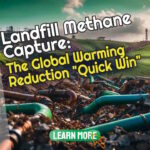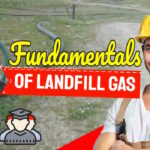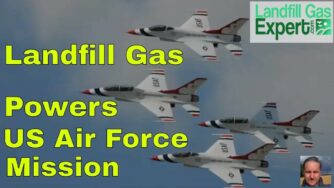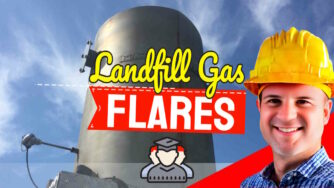Landfill gas migration is defined as the process which occurs when the landfill gas generated within a landfill moves from the site of original waste deposition out of the landfilled waste, into the surrounding environment.

This may take place as a result of the gas flow induced by the positive gas pressure produced by the gas output from anaerobic digestion process. This is due to the action of many millions methanogenic bacteria within the waste which give off the (largely methane) gas.
For the many sanitary landfills which have been built with a full “containment wrapping” (once permanent capping is complete) some migration may occur which is reportedly the result of diffusion through the landfill perimeter sealing layers/ membranes. Low permeability landfill seals made from clay may be the most susceptible to landfill gas migration through the clay materials.
A much lower landfill gas diffusion rate is quoted for plastic membrane seals, however, a plastic seal which deteriorates, rips or tears, may in the worst instances allow large quantities of landfill gas to escape it's landfill containment.
We suggest that you might like to watch our video below which explains why the gas industry flares off the gas it cannot use, and we suggest that you return for more information about Landfill Gas Migration after watching:
Most landfills which are built to the current landfill standards, including the EU Landfill Directives minimize the risk of landfill emissions, including landfill gas migration, by requiring composite linings.
Composite landfill lining requires two layers of low permeability membrane, and to comply with this requirement, landfill designers usually combine an inner layer of plastic membrane with an outer layer which is clay based. Bentonite (clay) embedded in a suitable geotextile which expands on contact with water, may be used instead of a natural clay layer, in combination with a plastic membrane.
Landfill gas migration incidents which occurred in the UK prior to modern landfill containment, and the installation of landfill gas extraction systems, were far more serious than any which have occurred since in the UK.
The waste management industry generally considers that landfill gas migration is a minimal risk for current “sanitary” landfills built to the “containment principle”, and quality assured during construction. There is little or no LFG migration risk to the public and the environment for all landfills engineered and operated to normal good practice standards globally.
Landfill Gas Migration Hazards
Should significant volumes of landfill gas migration occur in gas-permeable geological strata the consequences may cause:
- vegetation die-back and crop loss in the areas around the landfill
- a substantial risk of explosion, flash-over or fire above and below ground in the affected area
- asphyxiation of workers entering basements and chambers below ground in the zone in which migrating landfill gas is present
- asphyxiation of workers entering basements and chambers below ground a surprising large distance from the landfill source.
The above hazards do not apply to engineered containment landfills carried out in accordance with “sanitary landfill construction” (i.e. compliance with the EU Landfill Directives”).
While, 1 to 3 above might be considered to be a logical risk, few would anticipate the large distances over which landfill gas migration has been found, through UK experience to occur in a handful of exceptional cases. Such exceptional case generally occurred before landfills were lined and capped with low permeability seals to current EU Directive and global sanitary landfill standards.
Landfill Gas Migration Incidents
In the UK from the mid-1980s to late 1990s, landfill gas migration incidents did occur which resulted in injury and death. Some of these are recorded on this website here.
The severity and characteristics of landfill gas migration vary according to the type of landfill construction, as follows:
- Un-engineered uncapped tip site without a geomembrane or clay sealing layer below or up the sides of the waste.
- Ditto., but with a low-permeability capping.
- Sanitary landfill with a geomembrane or clay sealing layer below or up the sides of the waste, plus a geomembrane or clay engineered low permeability cap.
Migration is also affected by the permeability of the ground and other factors, such as pressure differences in the soil. It can be made to extend unexpectedly long-distances when the geology provides cavities (e.g. fragmented or cracked strata such as coal seams) which are able to conduct a landfill gas flow. The next migration hazard is buried pipes, and tunnels. Changes in atmospheric pressure and a low water table can also encourage this migration.
A rash of LFG migration incidents occurred in the 1980s when unlined landfills started to produce landfill gas, and in an effort to reduce leachate production were capped with low permeability clays. The resulting gas pressure build-up in the landfilled waste caused the landfill gas to move out laterally through the unlined landfill walls common at the time.
LFG Migration and Buildings
Steps must be taken to prevent this migration from the landfill site as it might enter buildings in the vicinity. This is done on the site by means of combinations of geomembranes and clay based products, see LFG migration protection.
Migration from the landfill site must be prevented from entering buildings in the vicinity. This can be done on the site by means of combinations of geomembranes and clay based products placed directly below floors. See gas protection for buildings.
Gas protection for buildings usually consists of an impermeable gas membrane. It also may include a layer, or an under-croft (ventilated air void) below a building where the gas will collect and be vented in a controlled manner. via en.wikipedia.org
Landfill Gas Migration Gases
The migrating gases can include methane (CH4), carbon dioxide (CO2), hydrogen (H2), and volatile organic compounds (there are approximately 500 others that can be present in trace forms) from the waste on site and its degradation over time.
Landfill Cover Materials as Factors which Affect LFG Migration
The direction, speed, and distance of landfill gas migration depend on a number of factors, described below.
- If the landfill cover consists of relatively permeable material, such as gravel or sand, then gas will likely migrate up through the landfill cover.
- If the landfill cover consists of silts and clays, it is not very permeable; gas will then tend to migrate horizontally underground. If one area of the landfill is more permeable than the rest, gas will migrate through that area.
Natural and Man-Made Pathways
Drains, trenches, and buried utility corridors (such as tunnels and pipelines) can act as conduits for gas movement. The natural geology often provides underground pathways, such as fractured rock, porous soil, and buried stream channels, where the gas can migrate.
Wind speed and direction. Landfill gas naturally vented into the air at the landfill surface is carried by the wind. The wind dilutes the gas with fresh air as it moves it to areas beyond the landfill.
Weather and Climate Related Factors which May Affect LFG Migration
Wind speed and direction determine the gas's concentration in the air, which can vary greatly from day to day, even hour by hour. In the early morning, for example, winds tend to be gentle and provide the least dilution and dispersion of the gas to other areas.
Wet surface soil conditions may prevent landfill gas from migrating through the top of the landfill into the air above.
Rain and moisture may also seep into the pore spaces in the landfill and “push out” gases in these spaces.
Gas movement is influenced by variations in the groundwater table. If the water table is rising into an area, it will force the landfill gas upward.
Increases in temperature stimulate gas particle movement, tending also to increase gas diffusion, so that landfill gas might spread more quickly in warmer conditions.
Although the landfill itself generally maintains a stable temperature, freezing and thawing cycles can cause the soil's surface to crack, causing landfill gas to migrate upward or horizontally.
Frozen soil over the landfill may provide a physical barrier to upward landfill gas migration, causing the gas to migrate further from the landfill horizontally through soil.
Barometric and Soil Gas Pressure
The difference between the soil gas pressure and barometric pressure allows gas to move either vertically or laterally, depending on whether the barometric pressure is higher or lower than the soil gas pressure. When barometric pressure is falling, landfill gas will tend to migrate out of the landfill into surrounding areas. As barometric pressure rises, gas may be retained in the landfill temporarily as new pressure balances are established. via www.atsdr.cdc.gov
LFG Migration Control Measures Implemented at Landfills
Many landfill operators install gas control measures because of regulatory requirements.
In the US the federal government has developed laws and regulations that govern the operation and maintenance of landfills. These regulations have been developed to reduce health and environmental impacts from landfill gas emissions through the reduction of ozone precursors (volatile organic compounds and nitrogen oxides), methane, NMOCs, and odorous compounds. States may also have state-specific landfill regulations, which must be as strict or more strict than the federal regulations.
Odour Migration in Air/ Air Quality Near Landfills
Odor complaints and potential safety and health concerns from inhaling low (trace) concentrations (in-air) of potentially hazardous gases may also prompt a requirement for landfill gas extraction and collection.
Sulfide emissions are a common source of landfill odor complaints, with the emission of hydrogen-sulphide being the worst of these. Hydrogen sulphide (chemical composition H2S) is the gas which smells like bad-eggs!
At older US landfills or at smaller US landfills exempt from federal and state regulations, uncontrolled releases of landfill gases can pose potential safety and health concerns (e.g., explosion hazards). In such cases, the landfill might implement landfill gas control measures, even if they are not required by federal or state regulations.
Some landfills have also implemented voluntary gas collection and control or treatment systems to recover landfill gas profitably, for energy production.
The Landfill Gas Control Plan
The Landfill Gas Control Plan for a landfill site is a US requirement, and such plans are devised by landfill gas operators.
The aim of a landfill gas control plan is to prevent people from being exposed to landfill gas emissions.
This goal can be achieved by either collecting and treating landfill gas at the landfill or by preventing landfill gas from entering buildings and homes in the community.
Technologies used to control landfill gas at the landfill or in the community can be applied separately or in combination.
Note that the NSPS/ EG requires a gas collection and control system design plan for landfills that meet their criteria. via www.atsdr.cdc.gov
Landfill Gas Use and Origins
Landfill gas use is the collection and treatment of methane or other gaseous substances from the decomposition of waste in a landfill to create power, heat, and energy. In addition to fossil fuels and farming, municipal solid waste (MSW) landfill gas was third in the world as the contributor to methane emissions as a greenhouse […]
Landfill Methane Capture: The Global Warming Reduction “Quick Win” You've Never Heard Of
Concerned about the menacing effects of landfill gas on our environment? You're not alone, but it's not as bad as it might be where a landfill has a well-engineered Landfill Methane Capture system installed. In fact, we go so far as to say that landfill methane capture and utilisation is the global warming reduction “Quick […]
Fundamentals of Landfill Gas
Understanding the fundamentals of landfill gas is crucial for environmental researchers, waste management professionals, and many others engaged in addressing climate change. A natural byproduct of organic material decomposition in landfills, this flammable gas plays a substantial role in global warming due to its composition. While not odorous if well managed it is closely associated […]
Landfill Gas Flares – Selection Installation And Maintenance
Landfill gas flares are now destined to be installed in a lot more landfills globally after COP26. This article is intended to help the anticipated influx of industry newcomers with their Landfill Gas Flare selection, installation, and maintenance. One of the international pledges made during the UN International Climate Change Conference 2021 otherwise known as […]








